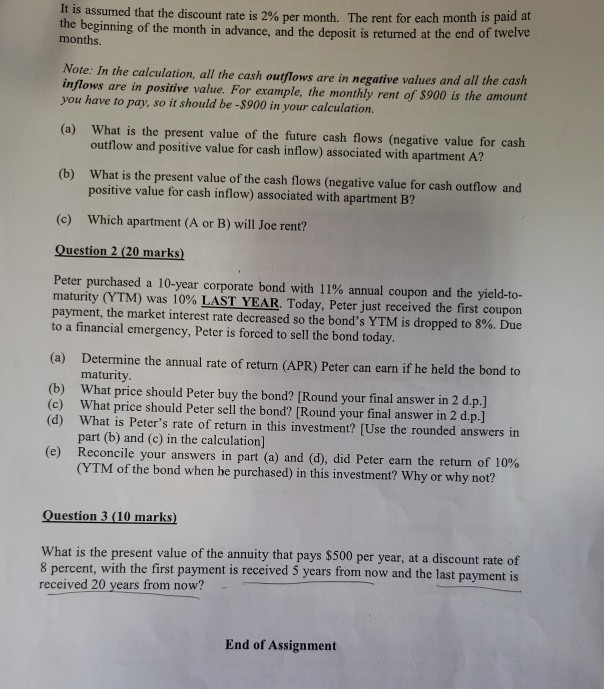Answered step by step
Verified Expert Solution
Question
1 Approved Answer
I dont know how to finish these 3 questions. Looking forward to your reply. Thanks Question 1 (20 marks) Joe got a job offer and


I dont know how to finish these 3 questions. Looking forward to your reply. Thanks
Question 1 (20 marks) Joe got a job offer and he decided to rent his own apartment. He visited apartment A and was very satisfied. He has already paid a deposit of $1,000 on a 12-month apartment lease, but he still has NOT paid the first month's rent and signed any contract yet. The monthly rent for apartment A is $1,000, and the deposit is refundable at the end of twelve months upon completion of the lease contract. The next day, Joe finds a different apartment B that he likes just as well, but its monthly rent is only $900. If he rents this apartment, he would again have to pay a deposit of $900 and that is refundable at the end of the 12-month contract. Joe now faces a dilemma - whether he should stay in the apartment A, or switch to the cheaper apartment (apartment B) and forego the deposit that he just paid. He decided to make a decision by comparing the present value of the FUTURE cash flows associated with the two apartment leases. is assumed that the discount rate is 2% per month. The rent for each month is paid at the beginning of the month in advance, and the deposit is returned at the end of twelve months Note: In the calculation, all the cash outflows are in negative values and all the cash inflows are in positive value. For example, the monthly rent of $900 is the amount you have to pay, so it should be-$900 in your calculation. (a) What is the present value of the future cash flows (negative value for cash outflow and positive value for cash inflow) associated with apartment A? What is the present value of the cash flows (negative value for cash outflow and positive value for cash inflow) associated with apartment B? (b) (c) Which apartment (A or B) will Joe rent? Question 2 (20 marks) Peter purchased a 10-year corporate bond with 11% annual coupon and the yield-to- maturity (YTM) was 10% LAST YEAR, Today, Peter just received the first coupon payment, the market interest rate decreased so the bond's YTM is dropped to 8%. Due to a financial emergency, Peter is forced to sell the bond today. Determine the annual rate of return (APR) Peter can earn if he held the bond to maturity What price should Peter buy the bond? [Round your final answer in 2 d.p.] (a) (b) (c) What price should Peter sell the bond? [Round your final answer in 2 d.p.] What is Peter's rate of return in this investment? [Use the rounded answers in (d) Reconcile your answers in part (a) and (d), did Peter earn the return of 10% (YTM of the bond when he purchased) in this investment? Why or why not? (e) Question 3 (10 marks) What is the present value of the annuity that pays $500 per year, at a discount rate of 8 percent, with the first payment is received 5 years from now and the last payment is received 20 years from now? End of AssignmentStep by Step Solution
There are 3 Steps involved in it
Step: 1

Get Instant Access to Expert-Tailored Solutions
See step-by-step solutions with expert insights and AI powered tools for academic success
Step: 2

Step: 3

Ace Your Homework with AI
Get the answers you need in no time with our AI-driven, step-by-step assistance
Get Started


